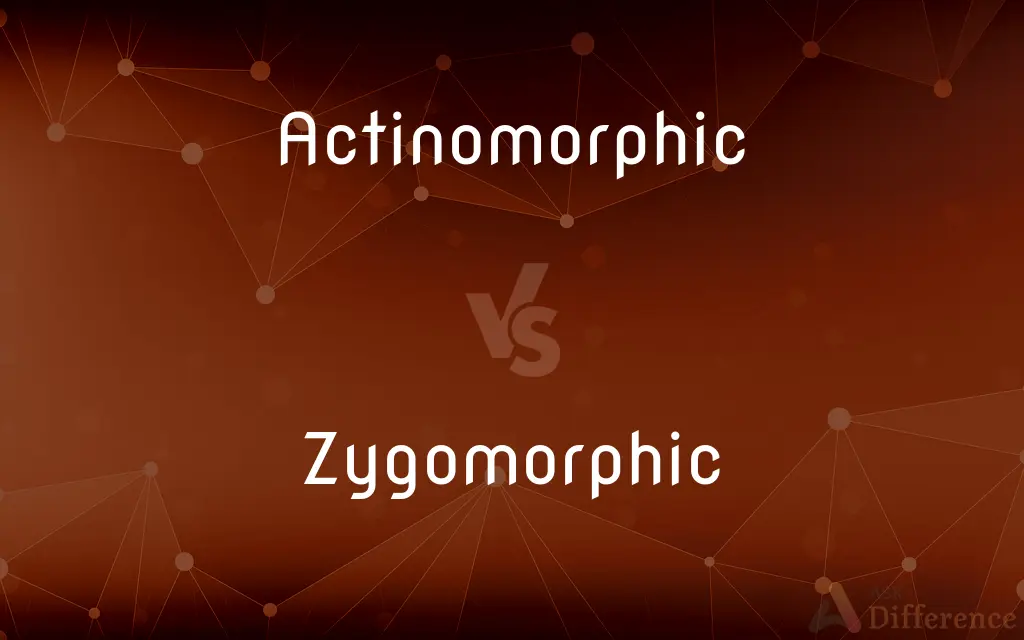Actinomorphic vs. Zygomorphic — What's the Difference?
By Fiza Rafique & Urooj Arif — Updated on April 16, 2024
Actinomorphic flowers exhibit radial symmetry, meaning they can be divided equally from multiple planes, while zygomorphic flowers show bilateral symmetry, divisible symmetrically only through one plane.

Difference Between Actinomorphic and Zygomorphic
Table of Contents
ADVERTISEMENT
Key Differences
Actinomorphic flowers, such as those found in the buttercup and rose families, are characterized by their radial symmetry. This means any line drawn through the center results in symmetrical halves. Whereas, zygomorphic flowers, typical of orchids and peas, possess bilateral symmetry, allowing only a single vertical plane to divide them into mirror-image halves.
The design of actinomorphic flowers often allows for a variety of pollinators, as their structure is accessible from multiple directions. On the other hand, zygomorphic flowers typically evolve to suit specific pollinators, which can interact with the flower in a particular way, often enhancing pollination efficiency.
Actinomorphic flowers are generally simpler in their floral structure and are found in a wide range of plant families. Whereas zygomorphic flowers often have complex structures that may include specialized petals, such as the lip of an orchid, which serves as a landing platform for pollinators.
In terms of evolutionary adaptation, actinomorphic symmetry is considered more primitive. This symmetry type appears in the earlier diverging plant families. Zygomorphic flowers, however, are viewed as an evolutionary adaptation to specialized pollination scenarios, often associated with advanced plant families.
The ecological role of actinomorphic flowers tends to be more generalized, supporting a diverse group of pollinators. Zygomorphic flowers, in contrast, are more specialized, sometimes even co-evolving with specific types of pollinators, which can influence the ecological dynamics of their habitats.
ADVERTISEMENT
Comparison Chart
Symmetry
Radial, multiple symmetrical planes
Bilateral, one symmetrical plane
Pollination
Allows various pollinators
Often specific to certain pollinators
Structural Complexity
Generally simpler
Often more complex
Evolutionary Aspect
Considered more primitive
Considered an advanced feature
Ecological Role
Supports a diverse range of pollinators
Often specialized to certain pollinators
Compare with Definitions
Actinomorphic
Exhibiting radial symmetry.
A daisy is an example of an actinomorphic flower.
Zygomorphic
Found in specialized ecological niches.
Zygomorphic flowers are often adapted to specialized ecological roles.
Actinomorphic
Symmetric in multiple planes.
Actinomorphic flowers like the lily can be divided into equal halves along several planes.
Zygomorphic
Symmetric only through a single vertical plane.
Zygomorphic flowers like orchids can be divided into mirror-image halves along only one plane.
Actinomorphic
Allows access from multiple directions for pollinators.
Actinomorphic flowers are accessible to bees from any direction.
Zygomorphic
Exhibiting bilateral symmetry.
The snapdragon is a typical zygomorphic flower.
Actinomorphic
Generally simpler in floral structure.
Actinomorphic flowers tend to have a simpler, open floral design.
Zygomorphic
Associated with complex petal structures.
The specialized lip petal of zygomorphic orchids aids in attracting pollinators.
Actinomorphic
Found in a wide range of plant families.
Many plant families, including Rosaceae, feature actinomorphic flowers.
Zygomorphic
Evolved for specific pollination interactions.
Zygomorphic flowers often evolve to match the body structure of specific pollinators.
Actinomorphic
Capable of being divided into equal halves along any diameter, as the flowers of a rose or tulip; radially symmetrical.
Zygomorphic
Having bilateral symmetry, as the flowers of a pea plant.
Actinomorphic
Having its petals arranged in a radially symmetric fashion.
Zygomorphic
(biology) having bilateral symmetry
Actinomorphic
Capable of division into symmetrical halves by any longitudinal plane passing through the axis
Zygomorphic
Symmetrical bilaterally; - said of organisms, or parts of organisms, capable of division into two symmetrical halves only in a single plane.
Zygomorphic
Capable of division into symmetrical halves by only one longitudinal plane passing through the axis
Common Curiosities
Can you give an example of a zygomorphic flower?
Orchids and snapdragons are well-known zygomorphic flowers.
Can you give an example of an actinomorphic flower?
Roses and daisies are common examples of actinomorphic flowers.
How does pollinator access differ between actinomorphic and zygomorphic flowers?
Actinomorphic flowers are accessible from any angle, making them available to a variety of pollinators, whereas zygomorphic flowers are usually adapted to specific pollinators.
How do actinomorphic flowers support ecological diversity?
Their generalized structure supports a wide range of pollinators, contributing to broader ecological interactions.
What role do zygomorphic flowers play in their ecosystems?
They often have co-evolved relationships with specific pollinators, influencing both plant and animal diversity in their habitats.
What defines bilateral symmetry in flowers?
Bilateral symmetry indicates that the flower can only be divided into symmetrical halves through one vertical plane, typical of zygomorphic flowers.
How do actinomorphic flowers adapt to multiple pollinators?
Their radial symmetry and simpler structure make them physically accessible to a variety of pollinators.
What are some structural differences between actinomorphic and zygomorphic flowers?
Actinomorphic flowers have a uniform structure around the center, while zygomorphic flowers often have differentiated petals.
Do zygomorphic flowers have any specific adaptations?
Yes, many have adapted physically to match the bodies of their pollinators, enhancing efficiency in pollination.
Why are zygomorphic flowers considered more evolutionarily advanced?
They often exhibit complex structures and specialized pollination mechanisms, indicating an advanced evolutionary adaptation.
What is radial symmetry in flowers?
Radial symmetry means the flower can be divided into equal halves along multiple planes, as seen in actinomorphic flowers.
Are actinomorphic or zygomorphic flowers more common?
Actinomorphic flowers are more common as they appear in both primitive and more evolved plant families.
Can the type of flower symmetry influence a plant's distribution?
Yes, flower symmetry can influence how a plant interacts with its environment and pollinators, potentially affecting its geographic distribution.
How do actinomorphic and zygomorphic flowers affect plant breeding?
Their different pollination strategies can influence breeding patterns, with zygomorphic flowers typically promoting cross-pollination with specific pollinators.
What is the significance of flower symmetry in plant evolution?
Flower symmetry can indicate the evolutionary path and pollination strategies of a plant, impacting its survival and reproduction.
Share Your Discovery

Previous Comparison
Nourishment vs. Food
Next Comparison
Autonomous vs. AnonymousAuthor Spotlight
Written by
Fiza RafiqueFiza Rafique is a skilled content writer at AskDifference.com, where she meticulously refines and enhances written pieces. Drawing from her vast editorial expertise, Fiza ensures clarity, accuracy, and precision in every article. Passionate about language, she continually seeks to elevate the quality of content for readers worldwide.
Co-written by
Urooj ArifUrooj is a skilled content writer at Ask Difference, known for her exceptional ability to simplify complex topics into engaging and informative content. With a passion for research and a flair for clear, concise writing, she consistently delivers articles that resonate with our diverse audience.














































